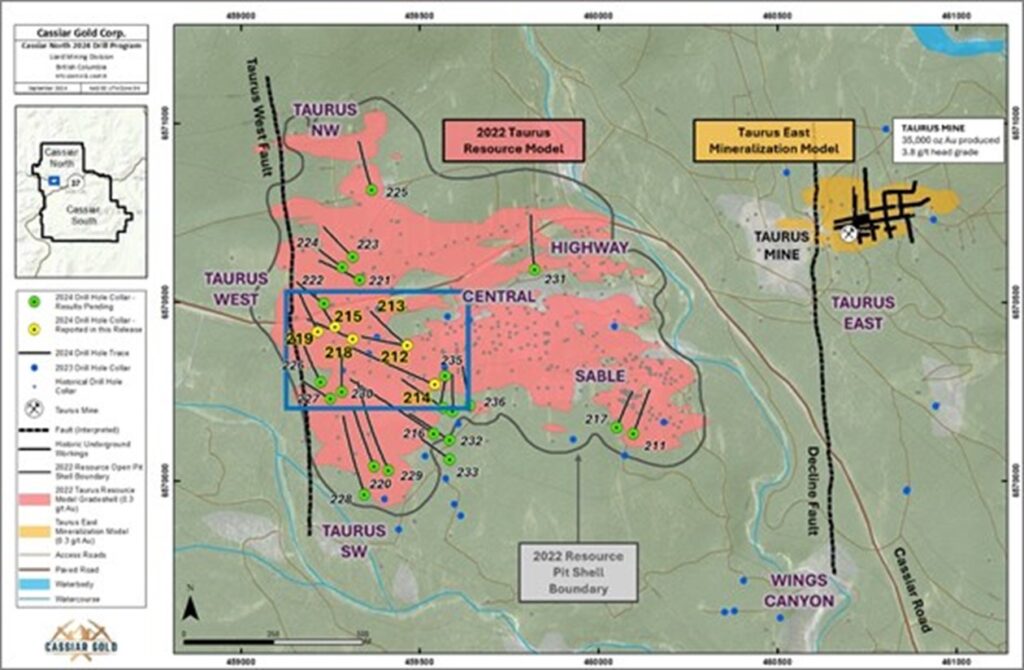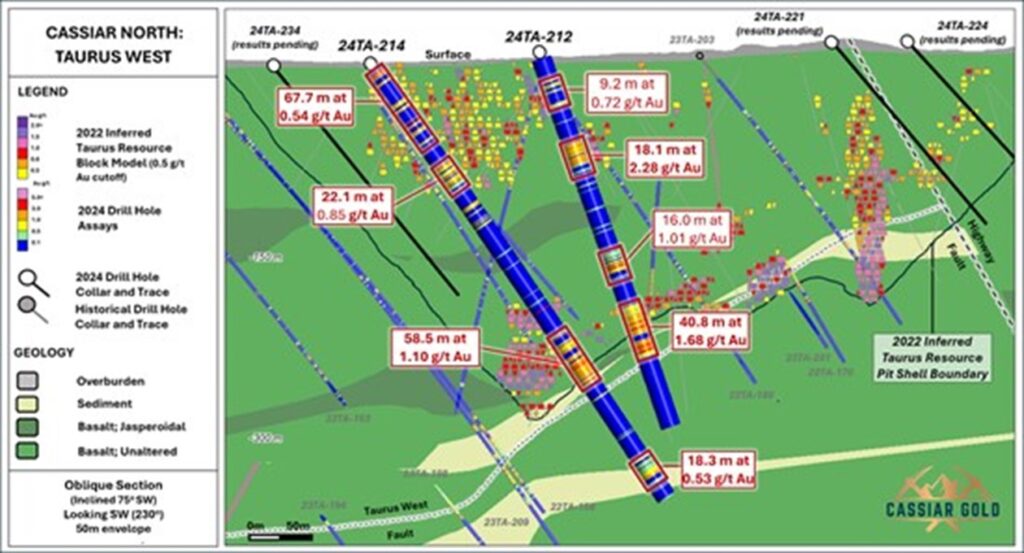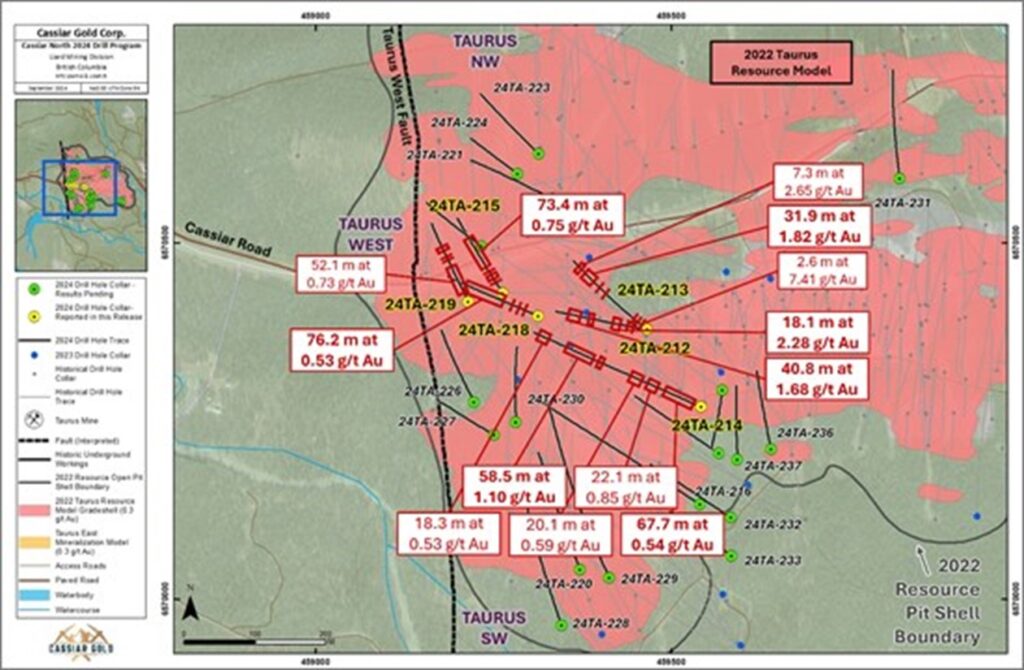
Cassiar Gold Encounters 40.8 m of 1.68 g/t Au and Expands Near-Surface Mineralization at Taurus Deposit

Cassiar Gold Corp. (TSX-V: GLDC) (OTCQX: CGLCF) is pleased to announce results from six initial diamond drill holes of the 2024 exploration program at the Cassiar Gold project, located in northern British Columbia. Results from these drill holes expand mineralization near-surface at the western extent of the Taurus deposit and demonstrate a continuous trend of south-plunging higher-grade mineralization along the Taurus West Fault. The 2024 drill program comprised 7,168 m over 30 drill holes and concluded at the end of August. Results remain pending for 5,596 m of drilling over 21 drill holes. Geophysical surveys, mapping, and soil sampling remain ongoing at the Cassiar Gold property.
Highlights:
- All drill holes from Taurus West reported here encountered multi-metre intercepts of mineralization above the 0.5 g/t Au cutoff of the 2022 Inferred Mineral Resource at Taurus, expanding mineralization near surface and establishing greater continuity at depth along the Taurus West Fault. The latest results include:
- 18.1 m of 2.28 g/t Au and 40.8 m of 1.68 g/t Au in drill hole 24TA-212
- 31.9 m of 1.82 g/t Au in drill hole 24TA-213
- 67.7 m of 0.54 g/t Au and 58.5 m of 1.10 g/t Au in drill hole 24TA-214
- 73.4 m of 0.75 g/t Au in drill hole 24TA-215
- 76.2 m of 0.53 g/t Au in drill hole 24TA-218
- 52.1 of 0.73 g/t Au in drill hole 24TA-219
“We are very pleased by these results from Taurus West. The new intersections expand near surface mineralization and provide a clearer representation of the continuity of mineralization along a key structure at the bulk-tonnage Taurus deposit.” stated Marco Roque, President and Chief Executive Officer. “Results from these drill holes strengthen our model and enhance the potential to expand the resource base at the Cassiar Gold project.”

Figure 1. Cassiar North 2024 drill campaign drill hole location plan map of infill and expansion drilling at the Taurus deposit, with locations of drill holes reported within this news release contained within the blue square (shown in detail in Figure 3). Drill hole numbers refer to holes with the prefix “24TA-“. Historical production figures from Taurus MINFILE Production Detail Report, file number 104P 012, BC Geological Survey.
Taurus Deposit
The Taurus Deposit hosts a substantial near-surface, bulk-tonnage Inferred gold resource of 1.4 million ounces grading 1.14 grams per tonne (g/t) gold (Au)1 which remains open. Since the early 2022 resource estimate, additional drilling has continued to expand the footprint of mineralization at the deposit, which remained a priority for optimization and expansion during the 2024 exploration campaign. A total of 27 drill holes and 5,923 m were completed at the Taurus deposit this season.
Taurus West Drill Holes
The latest drilling results reported in this news release are from six holes totalling 1,572 m which were drilled at the western extent of the Taurus deposit to evaluate the continuity of mineralization in untested areas between resource blocks along the Taurus West Fault (Figure 1). The drilling intercepts lie within the existing footprint of the inferred mineral resource, further defining and infilling the continuity of a wide, gently south-plunging higher-grade corridor and the distribution of near-surface mineralization along the Taurus West Fault corridor.
Drill holes 24TA-212, 24TA-213, and 24TA-214
Drill holes 24TA-212, 24TA-214, and 24TA-213 (northwest oriented) aimed to confirm near-surface mineralization and evaluate a previously untested area in a gap between resource blocks from the 2022 resource model along a south-plunging mineralized shoot along the Taurus West Fault at 50 m drill hole spacing. This drilling is designed as follow up to higher grade mineralization encountered in drill hole 23TA-187 (see NEWS RELEASE, September 12, 2023). Multiple intercepts were returned (Table 1; Figures 2,3):
- 18.1 m of 2.28 g/t Au from 74.3 m downhole, including 0.50 m of 26.30 g/t Au, and 40.8 m of 1.68 g/t Au from 209.40 m downhole in hole 24TA-212,
- 31.9 m of 1.82 g/t Au from 200.0 m downhole in 24TA-213, and
- 67.7 m of 0.54 g/t Au from 8.3 m downhole, including 4.0 m of 3.15 g/t Au, and 58.5 m of 1.10 g/t Au from 257.4 m downhole in 24TA-214.
These results confirm the distribution of near-surface mineralization, and expand mineralization beyond the extent of the block model at moderate depth, as well as within areas between resource blocks along the higher grade mineralized shoot at depth.

Figure 2. Oblique inclined section showing 24TA-212 and 24TA-214 at Taurus West, looking to the southwest. Assay results in red are reported in this news release. Section width +/- 25 m.

Figure 3. Plan view map of 2024 drill holes reported in this news release. The map location is shown in Figure 1. The vertical projection of mineralized intercepts reported in this release are included for reference.
Drill holes 24TA-215, 24TA-219, and 24TA-218
Drill holes 24TA-215, 24TA-219, and 24TA-218 (northwest oriented) were designed to evaluate the potential for near-surface mineralization to occur at depths shallower than the extent of the current block model, as well as test the continuity of mineralization at moderate depth in a gap between resource blocks thought to be attributed to widely spaced previous drilling (24TA-218).
All three drill holes encountered near-surface multi-metre intercepts of gold mineralization at depths shallower than the current resource blocks, while 24TA-218 successfully intersected mineralization within the gap between resource blocks, expanding mineralization over broad intervals where it was not previously defined. Results included (Table 1; Figure 3):
- 19.1 m of 0.51 g/t Au from 22.5 m downhole and 73.4 m of 0.75 g/t Au from 59.9 m in hole 24TA-215,
- 76.2 m of 0.53 g/t Au from 72.2 m downhole in 24TA-218, and
- 52.1 m of 0.73 g/t Au from 17.1 m downhole in 24TA-219
Drilling at Taurus West continues to demonstrate a more continuous trend of near-surface and south-plunging higher-grade mineralization along the Taurus West Fault than defined by the 2022 mineral resource estimate and highlight the potential for the ongoing expansion of near-surface mineralization within the footprint of the Taurus resource pit shell model.
Table 1. Significant 2024 drilling results from Taurus Deposit based on a >0.5 g/t cutoff. While true thickness has not been established, drill holes are designed to cross at high to moderate angles within known corridors of mineralization based on orientations of mineralized areas defined by previous drilling and structural data from oriented drill core and outcropping veins.
| Target Area | Drillhole | From (m) | To (m) | Length* (m) | Grade (g/t Au) | |
| Taurus West | 24TA-212 | 23.3 | 32.4 | 9.2 | 0.72 | |
| 41.4 | 42.9 | 1.5 | 0.69 | |||
| 74.3 | 92.4 | 18.1 | 2.28 | |||
| incl. | 74.3 | 75.3 | 1.0 | 3.64 | ||
| and | 85.0 | 86.0 | 1.0 | 3.12 | ||
| and | 91.9 | 92.4 | 0.5 | 26.30 | ||
| 165.3 | 181.3 | 16.0 | 1.01 | |||
| 209.4 | 250.2 | 40.8 | 1.68 | |||
| 24TA-213 | 4.8 | 7.3 | 2.6 | 7.41 | ||
| incl. | 6.5 | 7.3 | 0.8 | 17.90 | ||
| 16.8 | 18.3 | 1.5 | 1.50 | |||
| 32.0 | 33.8 | 1.9 | 1.53 | |||
| 153.9 | 157.8 | 3.9 | 0.73 | |||
| 180.1 | 182.0 | 1.9 | 0.79 | |||
| 200.0 | 231.9 | 31.9 | 1.82 | |||
| incl. | 213.0 | 221.7 | 8.7 | 2.95 | ||
| 252.2 | 259.5 | 7.3 | 2.65 | |||
| incl. | 254.4 | 259.5 | 5.1 | 3.60 | ||
| 24TA-214 | 8.3 | 76.0 | 67.7 | 0.54 | ||
| incl. | 9.0 | 13.0 | 4.0 | 3.15 | ||
| and | 55.3 | 56.4 | 1.1 | 4.29 | ||
| 93.9 | 116.0 | 22.1 | 0.85 | |||
| incl. | 106.5 | 107.2 | 0.7 | 3.72 | ||
| 135.0 | 155.1 | 20.1 | 0.59 | |||
| incl. | 148.0 | 148.6 | 0.6 | 5.38 | ||
| 234.2 | 235.0 | 0.8 | 3.61 | |||
| 257.4 | 315.9 | 58.5 | 1.10 | |||
| incl. | 266.1 | 266.8 | 0.7 | 3.20 | ||
| and | 285.2 | 288.4 | 3.2 | 3.01 | ||
| and | 297.4 | 301.7 | 4.3 | 3.08 | ||
| 372.3 | 390.6 | 18.3 | 0.53 | |||
| 24TA-215 | 22.5 | 41.6 | 19.1 | 0.51 | ||
| incl. | 24.8 | 25.2 | 0.4 | 3.60 | ||
| and | 33.9 | 34.3 | 0.4 | 5.53 | ||
| 59.9 | 133.3 | 73.4 | 0.75 | |||
| incl. | 68.5 | 73.8 | 5.3 | 1.20 | ||
| and | 113.8 | 133.3 | 19.5 | 1.22 | ||
| 24TA-218 | 21.6 | 23.6 | 2.0 | 1.05 | ||
| 31.9 | 38.7 | 6.8 | 0.54 | |||
| 49.0 | 51.0 | 2.0 | 0.62 | |||
| 72.2 | 148.4 | 76.2 | 0.53 | |||
| incl. | 118.3 | 120.9 | 2.6 | 7.49 | ||
| 24TA-219 | 17.1 | 69.2 | 52.1 | 0.73 | ||
| incl. | 17.1 | 17.6 | 0.5 | 4.30 | ||
| and | 64.4 | 65.4 | 1.0 | 3.14 | ||
| 85.0 | 85.4 | 0.4 | 2.52 | |||
| 89.4 | 91.2 | 1.8 | 0.59 | |||
| 105.8 | 114.0 | 8.2 | 1.23 | |||
| * Drill core lengths are reported here. True widths for these intervals have not been established | ||||||
Qualified Person
The technical information in this news release has been reviewed and approved by Jill Maxwell, P.Geo., Cassiar Gold Corp.’s VP Exploration, who is a Qualified Person as defined by National Instrument 43-101.
Quality Assurance and Quality Control
The 2024 Cassiar drilling program comprises HQ diamond drill core. Drill core samples are selected and logged by geologists prior to being cut in half using a diamond cutting saw at a secure facility located in Jade City, British Columbia. Certified gold reference standards and blanks are routinely inserted into the sample stream as part of the Company’s QA/QC program. All samples are delivered to the ALS Global preparation facility in Whitehorse, Yukon, then shipped to ALS Global preparation and analytical facilities in Vancouver, British Columbia. Samples are analyzed for gold by 50-gram fire assay with finish by atomic absorption or gravimetric methods. Screen metallic analysis is performed on selected samples. ALS Global quality systems and technical aspects conform to requirements of ISO/IEC Standard 17025 guidelines.
About Cassiar Gold Corp.
Cassiar Gold Corp. is a Canadian gold exploration company holding a 100% interest in its flagship Cassiar Gold Property located in British Columbia, Canada. The Cassiar Gold property spans 590 km2 and consists of two main project areas: Cassiar North, which hosts a NI 43-101-compliant inferred resource estimate of 1.4Moz at 1.14 g/t Au (cutoff grade of 0.5 g/t Au) known as the Taurus Deposit (see National Instrument 43-101 Technical Report on the Cassiar Gold property, April 28, 2022, by S. Zelligan, J. Moors, C. Jolette, which is available on SEDAR+); and Cassiar South, which hosts numerous gold showings, historical workings, and exploration prospects. Historical underground mines in the Cassiar South area have yielded over 315,000 oz of Au at average head grades of between 10 and 20 g/t Au1, underscoring the high potential for further discovery and expansion of high-grade orogenic gold veins.
The Company also holds a 100% interest in properties covering most of the Sheep Creek gold camp located near Salmo, British Columbia, Canada. The Sheep Creek gold district ranks as the third largest past-producing orogenic gold district in British Columbia with historical gold production of 742,000 ounces gold at an average grade of 14.7 g/t gold from 1900 to 1951. Minimal exploration work has been conducted since the 1950s.
Cassiar Gold Corp. acknowledges, respects, and supports the rights of Traditional First Nations in the lands and communities where we operate.
MORE or "UNCATEGORIZED"
Doubleview Extends High-Grade Domains at Hat: H099 Returns 438m of 0.40% CuEq Including 52m of 1.02% CuEq, Expanding Mineralization Envelope Around Conceptual Pit Vertically and Laterally
Doubleview Gold Corp. (TSX-V: DBG) (OTCQB: DBLVF) (FSE: 1D4) is pleased to announce assay results f... READ MORE
Cosa Closes Upsized C$7.5 Million Private Placement
Cosa Resources Corp. (TSX-V: COSA) (OTCQB: COSAF) (FSE: SSKU) is pleased to announce that it ... READ MORE
Americas Gold and Silver Closes US$132.25 Million Bought Deal Financing
Americas Gold and Silver Corporation (TSX: USA) (NYSE American: USAS) is pleased to report that it h... READ MORE
1911 Gold Closes C$23 Million "Best Efforts" Life Offering & Private Placement and Provides Corporate Updates
1911 Gold Corporation (TSX-V: AUMB) (FRA: 2KY) is pleased to announce that it has completed its prev... READ MORE
Endeavour Silver Completes US$350 Million Offering of Convertible Senior Notes
Endeavour Silver Corp. (NYSE: EXK) (TSX: EDR) announced today the closing of its previously announce... READ MORE












